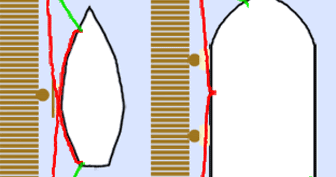
Repeat the process with your two stern lines. Keep in mind that you may sometimes need to crisscross them to get the correct angle. Using the techniques we discussed above to secure your lines to a piling or dock cleats, tie off a line to each bow cleat to keep the boat from moving side to side. The spring lines should be about one and a half times the length of your boat while the bow and stern lines can be at or just under the length of your boat. You’ll usually need six total lines: four lines for your bow and stern (two each) and two spring lines. The idea when tying up in a slip is to keep the boat far enough away from the dock, pilings, and other boats as to avoid hitting them, but not so far as to make boarding difficult. Either way, a slip or berth is a defined area between two piers, two sets of pilings, or a combination of the two. Tying up a in a slip or berth The terms “slip” or “berth” can generally be used interchangeably, depending on where you do your boating. This boater has attached his in an unconventional manner, since this is the boat’s home slip and the lines never come off the pilings. You’ll often use pilings for attaching your mooring lines. Or, you can put the bitter end of the dock line through the loop, lower it over the piling, then pull it tight. You can use either a clove hitch, which you can learn how to tie by watching our How to Tie a Clove Hitch video, or you can use a loop in the end of a line-either by tying a bowline (yes, we have a bowline video showing you how to tie this knot, too,) or using a line with a pre-spliced loop-and drape it around the piling. Tying off to a piling can be more challenging. If your dock lines have pre-spliced loops in them you can simply weave the loop through the center of the cleat (the eye) and then drape it back over both cleat horns before pulling it tight. The best way to learn it is by watching our How to cleat a Line video. Cleats and pilings Tying off to a cleat-either on your boat or on the dock-is easy. Knowing how to secure a line to both a cleat and a piling is vital to tying up your boat, so let’s have a look at how it's done. Some places will have a combination of both, while some have only one or the other. When you pull into a slip or alongside a pier or bulkhead you’ll usually encounter two things to tie your boat to: cleats and pilings. It's a good mooring job, though slightly ruined by the excess line left on the dock that could do with being neatly coiled. This boat has a bow line, a forward spring and an aft spring and a stern line – all attached to cleats. When a cleat is not present they can be used to secure a dock line. Some pilings stand on their own, while others have structures such as bulkheads, docks, or piers attached to them. Pilings: A piling is a long piece of timber or metal that’s driven into the bottom. Cleats: A cleat is a horn- or T-shaped piece of hardware on a boat or dock that’s designed to secure lines. Avoid the urge to call these “bumpers” at all cost this will mark you as a boating newbie.

They’re designed to cushion your boat when you’re tied up alongside a pier or bulkhead, or in any other instance when there’s simply no way to prevent your vessel from making contact with a dock, piling, pier, or another boat. Other mooring gear Fenders: Fenders can be anything from a flat piece of foam to a large inflatable rubber buoy. Stern Lines: Stern lines prevent the stern of a boat from moving side to side or, when tying up alongside a bulkhead or pier, a stern line keeps a boat from drifting away from the dock. Generally only two of these lines are required, but as many as four are sometimes used, depending on the situation.

Spring Lines: Spring lines keep a boat from moving forward or aft. Breast Lines: Breast lines are used to keep a boat from moving away from a pier, or to make it easier when pulling the boat closer for easier boarding. A bow line also keeps a boat from drifting away when tied alongside, such as when you’re tied off to a bulkhead or pier. Lines Bow Lines: Bow lines stop the bow of a boat from moving side to side. Does this boat look securely moored, to your eyes? As with most nautical activities, it’s worth starting out with a look at some basic nomenclature that helps to define the main concepts.


 0 kommentar(er)
0 kommentar(er)
